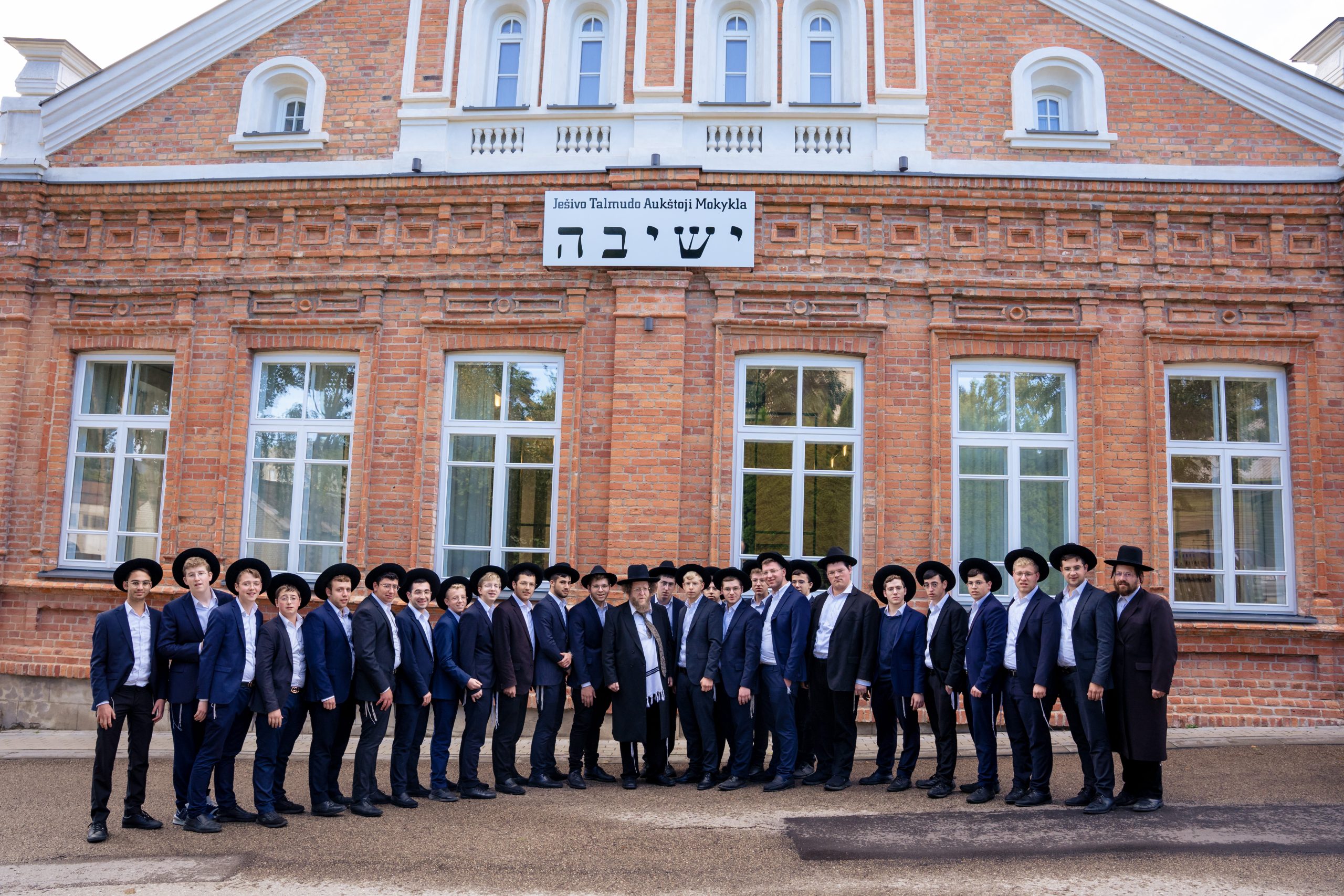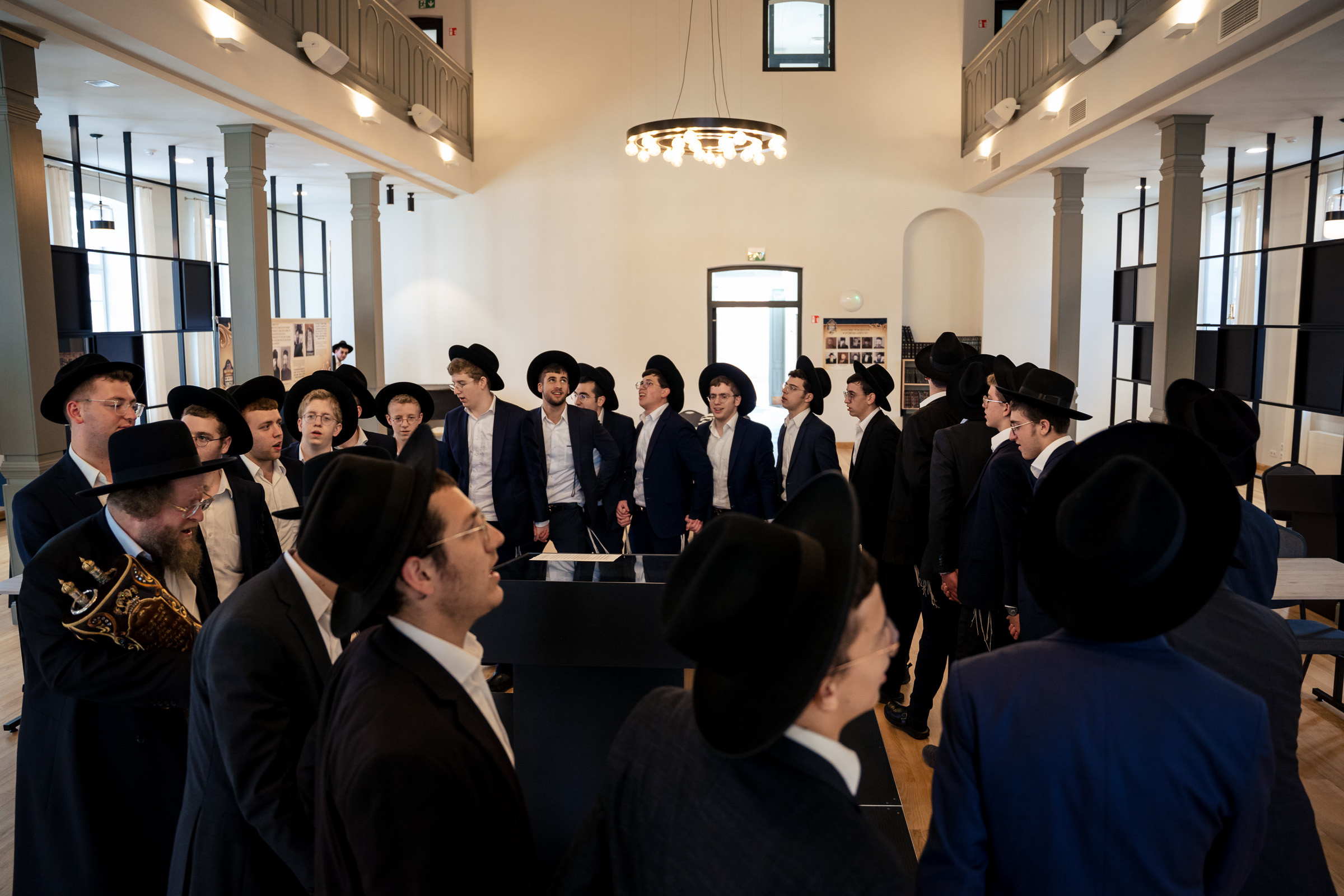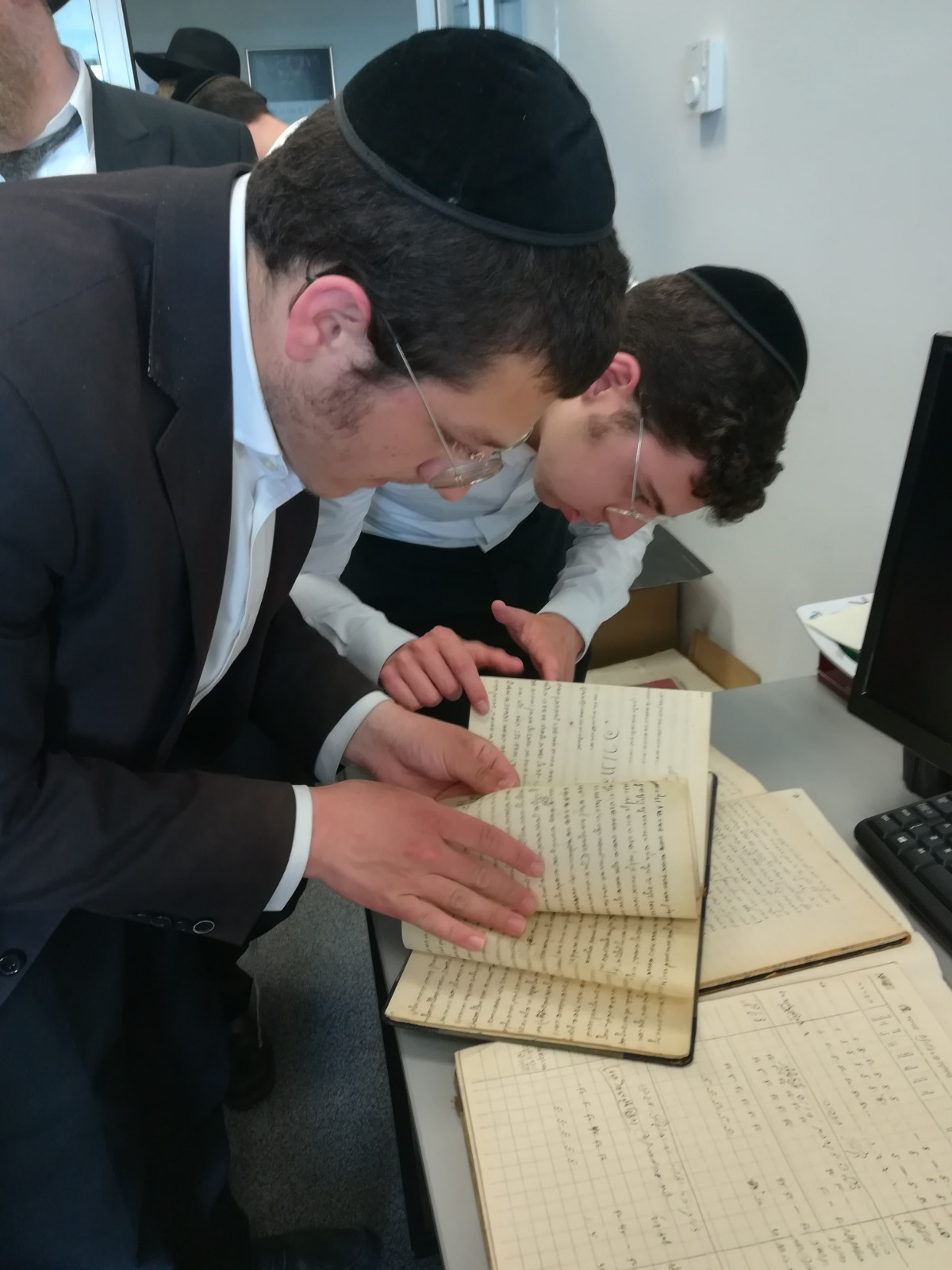Av 5,784/2023. Eighty-two years after the rabbanim and talmidim of the Telshe Yeshivah were sacrificed al kiddush Hashem, and eighty-three years after the expropriation of the yeshivah building, the Lithuanian government gave the building back to the yeshivah administration in a touching ceremony.
Led by Rosh HaYeshivah HaGaon HaRav Shalom Ber Sorotzkin shlita, dozens of offspring of generations of Telshe Roshei Yeshivah journeyed to Telshe so that the voice of Torah could once again ring through the Yeshivah’s beis medrash. Bezras Hashem, this journey will serve as a prelude to the reestablishment of the Yeshivah, and Yeshivas Telshe will be the first devastated Lithuanian yeshivah to return to its former glory.
The unique journey to bring Torah back to the Telshe Yeshivah took place during summer bein hazemanim, under the heading, “L’hashiv Atarah.” Dozens of grandchildren of the Roshei Yeshivah of Telshe from Eretz Yisrael and around the world, headed by Rosh HaYeshivah HaGaon HaRav Shalom Ber Sorotzkin shlita traveled to Telshe. For more than a week, the bachurim hovered over their gemaras and studied Torah in the Telshe beis medrash, singing out the words of Abaye and Rava, day and night, in the sacred beis medrash.
The emotions in the beis medrash were overpowering. It was as-if the walls of the beis medrash had been standing, waiting and yearning, for eighty-two years. They craved and anticipated these very moments, when Torah would once again be heard within them. Those learning in the Telshe beis medrash were overwhelmed with sentiment; this is the very place where my forefathers learned Torah, where they davened. Ki hamakom asher atah omeid alav, admas kodesh hu.
The yeshivah building in Telshe was the biggest, central makom Torah in pre-war Lithuania. It was here that brilliant Gaonim taught Torah to Klal Yisrael; Torah that is still being transmitted onward today. It was a place where Gedolei Yisrael labored and toiled, wearing themselves out physically; a place where Kedoshei Elyon sprouted; and where the mesorah was transmitted to future generations, to the pre-war Torah world, reaching our generation.

Eighty-two years of desolation
Most of the buildings of the holy yeshivahs of Lithuania did not survive. The buildings are eternal, they will forever remain in our hearts, but their physical wood and stones have been desecrated and are long gone. Unfortunately, some of these buildings are now being used by non-Jewish institutions. In contrast, the Telshe Yeshivah building stood desolate and abandoned for decades, as if waiting to be redeemed.
In recent years, the local government, with the assistance of the European Union, decided to restore the yeshivah building. At the same time, contact was made regarding returning the building to the descendants of the founders and Roshei Yeshivah of Telshe.
This summer, an agreement was made and the local government decided to return the building to Yeshivas Ateres Shlomo, so that it can be reestablished as a makom Torah. To finalize the arrangement, the mayor of Telshe visited the Ateres Shlomo campus in Rishon LeZion.

Entering the Telshe Yeshivah
As they walked through the streets of the village that had once been described “as smelling like the Ketzos HaChoshen,” the bachurim on the “L’hashiv Atarah” trip broke out in song. Ashreinu mah tov chelkeinu, mah na’im goraleinu!
The procession of talmidim danced together with the Rosh Yeshivah shlita, as he clutched a Sefer Torah, preparing to enter the beis medrash.
The yeshivah building was decorated and illuminated, signs and banners had been prepared in honor of the yeshiva’s return. The mythological sign that had graced the front of the building during the years of its existence, hung once more on the façade. It clearly stated: ישיבה.
As they approached the building, the Rosh Yeshivah emotionally spoke about the magnitude of the event. He described the beis medrash that was saturated with Torah and about the kedushah of a makom Torah that is sanctified by the Torah learned within it. Chazal said that the stone that Rabbi Eliezer sat upon was like Har Sinai and the one who sat on it was like the Luchos HaBris, because they were part of the transmission of Torah to Klal Yisrael. Torah was disseminated to Klal Yisrael in this beis medrash, this is a place of mesirus haTorah, and those who sat and learned within it were the ones who transmitted the Torah.
The Rosh Yeshivah shlita added tearfully, “The yeshivah building was shuttered a year before the mass murder. My great-uncle, HaGaon HaRav Eliyahu Meir zt”l, said that this was the third time he took the Sifrei Torah out of the Yeshivah. The first time was during a fire, and he merited to return them. The second time was during the First World War, and he also merited to return them. He davened that Hashem should give him the privilege of returning the Sifrei Torah a third time.”
“Today,” Rav Shalom Ber said, “We are privileged to return the Sefer Torah. Torah is returning to its home.”
The Rosh Yeshivah continued to describe the events leading up to the deaths al kiddush Hashem of the rabbanim and talmidim of Telshe and the Jews in the city. He concluded, “Bringing back Torah to the yeshivah, the first time that Torah is returning to a Lithuanian Yeshivah, reestablishing what was murdered in the Holocaust Hy”d, is the greatest victory over the Nazis yimach shimam. This is a fulfillment of nikmas dam avadav...”

Baruch Matziv Gevul Almanah
The bachurim entered the Yeshivah, singing and dancing with emotion, thanking Hashem Who chose us from amongst the nations, asher bachar banu mikol ha’amim. They also gave thanks to Hashem for the great zechus of learning Torah in this holy place once more.
All those present trembled with emotion, as the Rosh Yeshivah shlita recited Baruch matziv gevul almanah, the brachah recited by those who merit to see destroyed Jewish homes rebuilt, along with the brachah of Shecheyanu.
Placing the mezuzahs on the Yeshivah’s entrances was also an inspiring event. A mezuzah was placed on the back doorway, now the entrance to the yeshivah building. (The doors that had been here currently grace the Yeshivah’s Kollel in Modiin Illit.) Rosh Yeshivah HaGaon HaRav Shalom Ber shlita put up the mezuzah at this entrance and Rav Shimon Levinger shlita put up the mezuzah in the inside entrance, as the talmidim sang and danced with the joy of the mitzvah.
After the opening ceremony, the bachurim sat down to learn and then davened Minchah in the beis medrash, as if this was a regular routine day in Yeshivah.
The talmidim later visited the kevarim of Maran Rosh Yeshivah HaRav Yosef Leib Bloch zt”l, author of Shiurei Daas, who is buried in the Jewish cemetery in Telshe, next to the kever of his wife. The bachurim spilled out their hearts and davened for an extended period of time. The bachurim then said Tehillim liluy nishmas all the Jews of Telshe buried in the cemetery and then returned to the beis medrash.
Once in the beis medrash, the talmidim bent over their gemaras, following yeshivah sedarim and tefillos every day for a week. They toiled over the sugya chosen to be studied in the Telshe Yeshivah: Baruch matziv gevual almanah and other brachos of sight, in Maseches Berachos. On Shabbos, the Rosh Yeshivah HaGaon HaRav Shalom Ber shlita gave a shiur klali, per the mesorah in Telshe, where shiurim klalim were given on Shabbos.
A building near the yeshivah was rented to serve as a dormitory and dining room for the bachurim. The kitchen in this building, nicknamed “kretchme” by the bachurim, was kashered for the talmidim and all food and kitchen utensils were purchased in advance to be used during the trip.
Parenthetically, tremendous efforts were put into the logistics of feeding the trip participants. Food with mehudar hechsherim was brought on the trip, along with a mashgiach kashrus who kashered the kitchen and supervised it during the trip.
The Yeshivah published a special calendar with the halachic zemanim in Telshe. Shekiyah in Telshe is very late. During the trip, shekiyah took place about 9:30 every evening.

Strong impact upon Lithuanian non-Jews
Since this was the first time since the Holocaust that a makom Torah was revitalized in the country, the L’hashiv Atarah trip and the Telshe bachurim’s return to the Yeshivah stirred interest in Lithuania.
During the trip, many journalists toured the Yeshivah to see its reestablishment. The Lithuanian Minister of Culture visited the Yeshivah and expressed his hope that Lithuanian Jewry would blossom once again. The mayor of Telshe and city council members also visited the Yeshivah.
Later on, when news of the terrible slaughter on Simchas Torah reached the Prime Minister of Lithuania, he visited the Telshe Yeshivah building to signify his empathy and solidary with the Jewish Nation.
Awe-inspiring!
For a complete week, the kol Torah echoed through the yeshivah building in which Gedolei Olam flourished, Gedolim who illuminated the way for our generation, Marana the Kovetz Shiurim and Marana Rav Naftali. The Roshei Yeshivah, the Ponevezher Rav, Rav Mottel Pogromansky, Rav Chatzkel Abramsky and Rav Eliezer Yehudah Finkel, those who established Torah in America, the Roshei Yeshivah in Cleveland….and the list goes on.
Kol haTorah was heard once again between the same columns and foundations, in the very place that the Gedolim of Telshe stood and transmitted Torah to the future generation. This is where Rav Leizer Telzer stood, as did Rav Yosef Leib, Rav Avraham Yitzchak, the Shaarei Yosher, and Rav Chaim Telzer. Rav Zalman, and his brothers Rav Eliyahu Meir and Rav Chaim Mordechai. We cannot describe or properly appreciate the sanctity of this place. It is Kodesh Kadashim! It was sanctified with the Torah, kedushah, ameilus, harbatzas haTorah and the mesirus nefesh of these Gedolei Olam. Mah norah hamakom hazeh, ein zeh ki im beis Elokim
The House of Rav Avraham Yitchak Hy”d and vestiges of Telshe Jewry
During the journey, the bachurim visited the remnants of the Telshe Jewish community. In addition to the yeshivah building, the building of the Kollel HaRabbanim headed by Maran HaGaon HaRav Chaim Mordechai Katz zt”l still stands near the yeshivah building, as it was when it was abandoned. The local mikvah which once served the thousands of Jewish residents of the city still remains in Telshe, connected to its source of fresh water.
The talmidim were excited to visit the home of Rav Avraham Yitzchak Bloch Hy”d, not far from the yeshivah building. Marks indicating where the mezuzah was once placed can still be seen on the doorway.
Torah, shiurim and the transmission of our mesorah took place in this sacred home. It was from this house that Rav Avraham Yitzhak Hy”d left to the Rainiai forest when the Jews of Telshe were sacrificed on the 20th of Tammuz. Rav Avraham Yitzchak stood at the front of the community and his Shema Yisrael rang out and echoed through the forest, as he was mekadesh shem Shamayim.
Inside the house, the talmidim started to sing with emotion and davened that we will soon merit the geulah and witness nikmas dam avadav.

National Library
At the conclusion of the trip, the bachurim traveled to Kovno, where they davened in the Jewish cemetery at the kever of HaRav Chaim Rabinowitz ztzl, Rav Chaim Telzer, Rosh Yeshivah of Telshe for decades. They also davened at the kever of Maran Rav Yitzchak Elchonon Spector zt”l and at the kever of the Dvar Avraham zt”l.
The talmidim also made a special trip to the Lithuanian National Museum in Vilna, where the curator showed them treasures, vestiges of the village of Telshe and its yeshivah. The talmidim were shown documents from the life of the Yeshivah, acceptance letters, journals and diaries, notes from the Yeshivah administration and a few notebooks of chiddushei Torah written by Yeshivah talmidim.
A tremor of excitement went through the talmidim when they saw a rare notebook of chiddushei Torah written by the Rosh Yeshivah Maran HaRav Avraham Yitzchak Hy”d. This was one of the dozens of manuscripts of chiddushei Torah manuscripts written by HaRav Avraham Yitzchak. Some of the manuscripts were lost, and others are in the possession of his descendants and were published over the years. The rare notebook in the museum is full of illuminating chiddushei Torah and shiurim written in his hand.
The talmidim then davened at the kever of Marana Meor Eineinu, the Gra of Vilna.
Reviving the Glory
At the conclusion of the L’Hashiv Atarah trip, the talmidim left the yeshivah building inspired and elevated, with a tefillah on their lips that they soon see Torah return to the place where the Gedolim studied Torah. They left with the hope that the voice of Torah and tefillah will once again be heard in the building until Mashiach’s coming, and that this historic trip will open a new chapter in the golden chain of Torah transmission from generation to generation.

Ani Maamin at the mass grave in the Rainiai Forest
One of the most emotional events of the trip was the visit to the mass grave in the Rainiai Forest, near the city of Telshe, where more than 7,000 Jews were murdered al kiddush Hashem by the Nazis on the 20th of Tammuz, 1941. This is the mass grave of the Rosh HaYeshivah HaGaon HaRav Avraham Yitzchak Hy”d; his brother, the Mashgiach of Telshe, HaGaon Rav Zalman Hy”d; his brother-in-law, Rosh Yeshivah of the younger talmidim, Rav Avner Akolianski Hy”d; Rosh Mesivta, HaGaon HaRav Ezriel Rabinowitz, and many other rabbanim from the yeshivah, together with thousands of Jews of Telshe Hy”d.
The descriptions of the spiritual heights of the Jews of Telshe until the terrible day, the 20th of Tammuz, are awe-inspiring. A few days earlier, all the men of Telshe were taken to this forest. With mesirus nefesh and kabbalas ol malchus Shamayim, in kedushah and teharah, they were killed al kiddush Hashem. As the Nazis cocked their rifles, Rav Avraham Yitzchak’s last cry rang through the forest: Shema Yisrael Hashem Elokeinu Hashem Echad!
The night before, in the camp near the Rainiai Forest, Rav Avraham Yitzchak Hy”d spent his time studying Hilchos Kiddush Hashem of the Rambam. And in the morning, before leading the kedoshei Telshe to this very spot, Rav Avraham Yitzchak Hy”d washed his hands and purified himself by saying viduy.
The wicked fire burned the scroll, but the letters flew up in the air, and the sanctity, spirit and spiritual strength remains forever, because the flame of Torah that they illuminated cannot be extinguished by worldly fire or water. The blasphemous horror cannot overcome the strength of their mesirus nefesh al kiddush Hashem…
This site, this cursed place, served as an altar where Jews were sacrificed al kiddush Hashem. The talmidim stood there, reciting Tehillim and selichos at this mass grave, with tears in every eye and emotions high…
And that same song that a few talmidim of the Telshe Yeshivah sang in face of those wicked murderers when they realized that their end was near, the same song that made its way to the Kisei HaKavod, was heard once again at this mass grave, decades later: Ashreinu mah tov chelkeinu u’mah na’im goraleinu!
The bachurim sang for a long time in the Rainiai Forest. Standing on ground seeped with the blood of pure Jewish martyrs Hy”d, they sang songs of inspiration, davening for Mashiach and the redemption of our nation.
And at that moment it seemed that even the forest, the trees and the grass, joined silently in the song and tefillos, pleading that we soon witness nikmas dav avadav hashafuch.